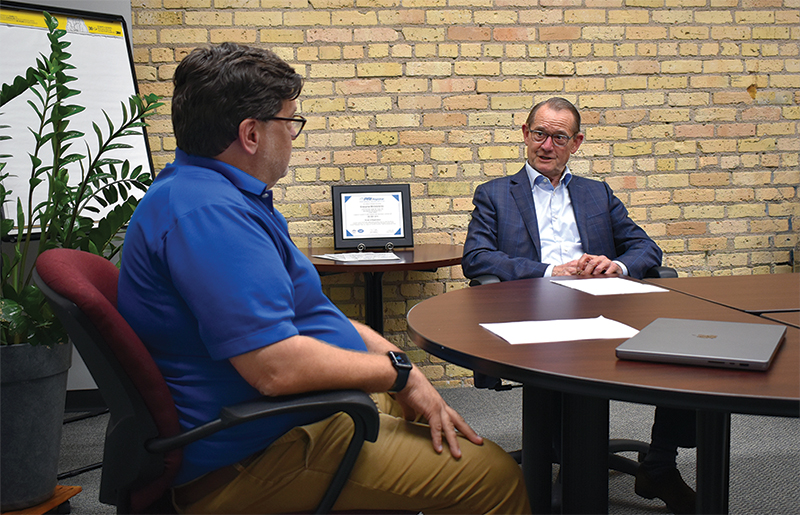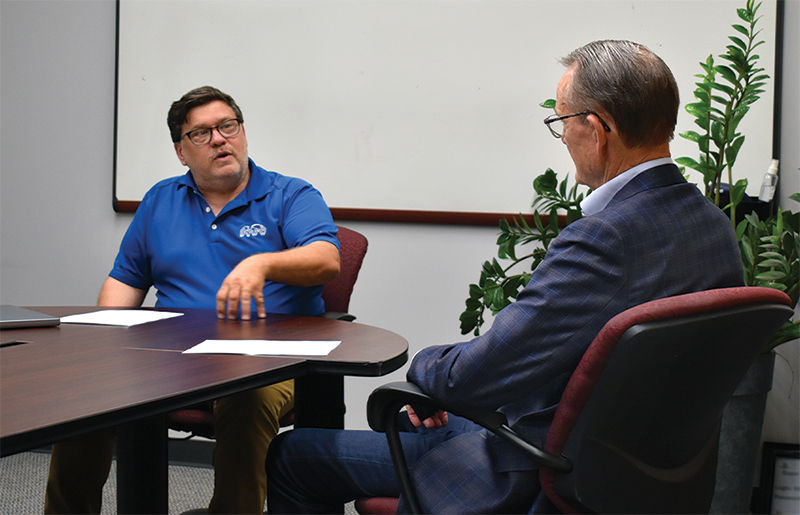To better serve ISO clients, Enterprise Minnesota 10 years ago initiated the process of getting certified itself, a relative rarity for a service organization. After recently passing its 10th annual audit, Enterprise Minnesota’s president and CEO sat for a conversation with Thomas Paserba, the ISO auditor who has conducted each audit. Paserba, a vice president at the Pennsylvania-based International Quality Consultants, began his career as a high school instructor, teaching U.S. history in Colorado and at an international school in Venezuela. Since joining the company, he has audited organizations on every inhabited continent in the world.

Bob Kill: I imagine many companies begin their ISO journeys because customers have asked them to. But do you see that many of them ultimately understand it as a powerful tool for managing their business?
Thomas Paserba: We hope they do. Some companies will always look at ISO as a piece of paper that will help them get business. But we hope they gather enough information over time to see the value that this system can bring them. Quality is a management system. It’s never going to be the thing that grows their company into a Fortune 500, but they can use it as the framework to make their company better. If you put in the time and effort, those tools are going to make any company better. It’s not a guarantee, but it is a peace of mind.
You’ve just finished your 10th audit with Enterprise Minnesota. Do you like to build relationships with clients over the years? Or does your employer want you to move from one to the other?
Paserba: There are benefits, and there are drawbacks. Strong connections with clients help the audit go easier and make the whole process more relaxing for the auditee. They trust that you’re not there to belittle or berate them but to help. But it is also important to remember that clients are not friends; it’s a professional relationship. I reject friend requests on social media because that’s not a bridge we want to cross. We have to avoid anything that can influence our perspective on what they’re doing.
What is the optimal perspective a company can take to an ISO audit?
Paserba: Look at it as a chance to learn. You go into a certification audit knowing there will probably be findings. It’s not personal, it’s not punitive, it’s just a teaching tool. We’ll walk you through the findings and make sure you understand what’s required to address it. We point things out that allow the company to continue to grow within its system.
Is there sometimes a disconnect between management and the rest of the company over how the audit is being utilized?
Paserba: A lot of problems with quality management systems are because ISO relied on the quality department to be the focal point of the quality system before the 2015 standard. ISO 2015 wanted everyone to have a role. I still see companies that have the old mindset that the quality departments should take responsibility for a finding or a customer complaint instead of getting everyone involved. That’s a mistake because you’re taking away the people who are most capable of facilitating improvement. There’s a difference between quality assurance and quality control. Quality control focuses on the product, whereas ISO 9001:2015 is quality assurance, a top-down holistic system for the whole business.

What’s the value of internal auditing?
Paserba: They know that they have a list of things to do, and they do it. Employees often put their purchase orders out, but they don’t always understand the standard or the requirements or why they’re there. So, the evolution of quality, especially with ISO 9001 from ’94, was focused purely on product. As you got to 2008, it was management and product, and now it’s more about how management drives product improvement.
Internal auditing helps everyone see their impact on quality. And the hope now is that the people involved can look at the data points and say, “How does that play into purchasing?” For example, a lot of companies look at on-time delivery as product going out the door. But on-time delivery can be impacted by purchasing because if they need the proper lead times to quote, then they’re promising your customer something too early; material is delayed coming in, which delays the product going out the door. Sales can also impact on-time delivery. If sales personnel over-promise what you can realistically do to get the numbers on the books, you can be late on the product. And that becomes a problem with the customer.
I always encourage organizations — especially smaller ones — to use auditors from different departments to audit. Having a purchasing person audit manufacturing or a salesperson audit purchasing will help them see how everything is connected. It will also help them grow their knowledge and broaden their perspective on the overall company rather than being isolated in their specific areas.
We have many very small companies with one or two key customers who have encouraged them to get certified. They’re sometimes nervous because they believe ISO’s documentation involves paperwork that will restrict their flexibility, etc. What do you tell them?
Paserba: A quality manager once asked whether I wanted to see his unabridged manual or his abridged manual. I asked, “Why do you have two?” The unabridged version was about two feet high. Over time, auditors told them they needed things, and he kept on adding and adding and adding. I said, “OK, get me the abridged.” And so, the answer to your question from small companies is that the ISO standard requires you to document only what you want to document — what you need — not what the ISO standard says.
Certain areas, like management review, prescribe specific requirements about what you should talk about when you have a meeting or do an internal audit, but it does not tell you what to document. Too many companies overthink this and document everything. Or they panic and write a quality management system because they think that’s what the auditor wants. The last thing a company should ever do is write a quality system for what the auditor wants; they should always write it for what’s best for their company. If they do that, they will be great 90% of the time. They might have findings, but that’s not the end of the world. Findings are there to help them fix and grow, not to punish.
We avoid unnecessary documentation by focusing on four categories of key stakeholders. And one key stakeholder is employees.
Paserba: More and more companies are evaluating employees as interested parties. They look to drive improvement that shows employees that they matter, such as upgrading break areas. This demonstrates that the organization wants to continue to grow with them, as opposed to ignoring the employee as someone who can be replaced.
If your HR department’s not keeping up with your employees, your quality will suffer and in turn, your customers will suffer. Rotating out a large employee turnover will impact your quality because you need to spend more time and money on training. A revolving door of new people will cause your product to have problems; you’ll have higher scrap rates or rework rates. Plus, you don’t know the new people coming in, their personalities, etc. It shakes everything up every time. So again, HR plays a role in quality.
How often do you go into a first-time certification, shake your head, and say, “They weren’t ready. They haven’t really been serious about this”?
Paserba: I think everyone is serious about it, but some people are in over their heads. We’ve not certified some companies that just didn’t know what they were doing or built a system that was overcomplicated for the number of people that they had to execute it.
Are there things you recommend as a last-second check-and-balance before an audit?
Paserba: A good quality system for any organization, large or small, is something they’re living and breathing every day. I should be able to walk in off the street, knock on the door and say, “I’m here for an audit,” and it shouldn’t matter. We’re there to audit the system and not the individuals. So, it shouldn’t matter who is there. That said, it is always good to double-check housekeeping. Get rid of the clutter. The more paperwork that’s out there — or gauges lying around — the more likely I will find something. We’re like the police. I’m allowed to look at anything in plain sight. I’m not going to open drawers or invade anyone’s personal space, but if you leave it out there for me to see, I’m going to audit it.
How often are you confronted by acrimonious attitudes from certain people at a company?
Paserba: In the philosophy of quality, two things are certain: People hate change, and change is inevitable. I’ve had people swear at me on audits, and again, I don’t get upset because I get to walk away. And if it’s really bad, you just say, “Let someone else deal with them for a year and see what happens.” The beauty of being an auditor is that you’re like a grandparent. You can send the kid home at the end of the day, no matter what. My responsibility ends with what I can flag and what I can write up. I can’t factor in a person’s acrimony and or confrontations about my decisions. I once wrote a finding at a union shop because an employee was not following the requirements of the system. At some point, the union lead confronted me about why I’d written the finding. Again, I’m here to audit the system, not the employee. I said, “I’m writing the finding no matter what. This is a finding on the system, not on the worker. It’s not personal.”
You have said that from a long-term strategic perspective ISO can contribute to the legacy of an organization.
Paserba: A quality system is about consistency. It’s about continuity. It’s about mitigating the departure of someone who’s been there for 20 or 30 or 40 years. I was auditing an environmental group at the Pennsylvania Department of Transportation. The young woman I audited was leaving the department. She walked me through all the requirements — all the rules and regulations — that went into road construction and projects, which were insane. For example, they were working on a project on a bridge, and they found two bats underneath it. The project was delayed by two years because they had to figure out what to do with the bats because they’re endangered. I asked her, “How do you pass that knowledge on?” And she showed me a document that she had been working on to help the next employee. When I asked her why she did it, she said, “When I started, there was no one here to teach me. I didn’t want the next person to go through what I went through.”
That’s legacy. Because now that next person has a guideline. Legacy is how you preserve your knowledge and best practices when you leave so that the next person doesn’t have to start over.
Return to the Fall 2024 issue of Enterprise Minnesota® magazine.


